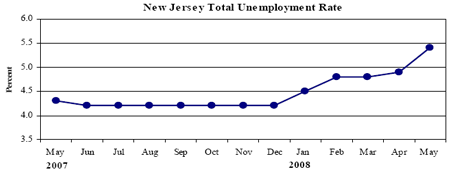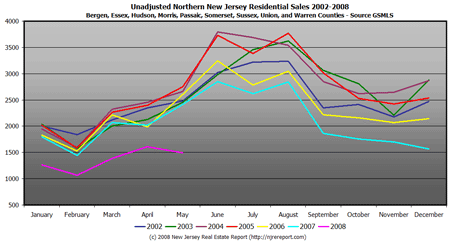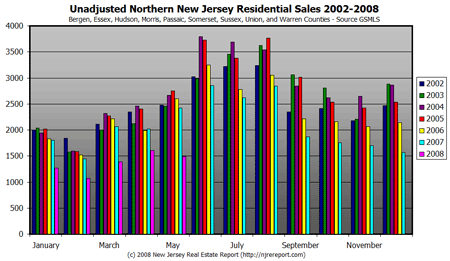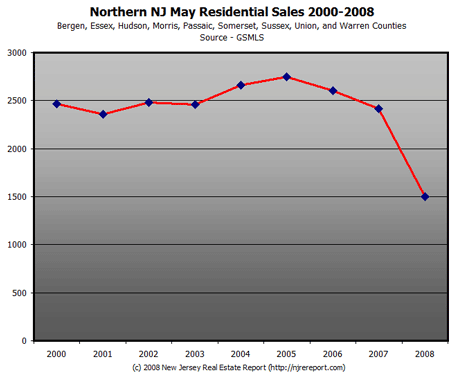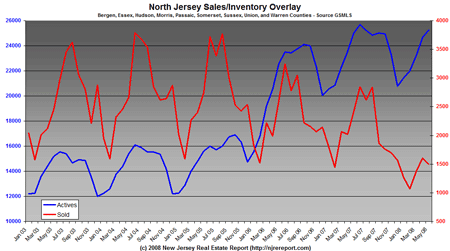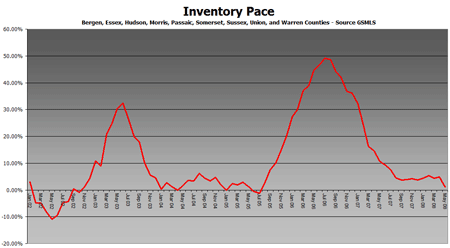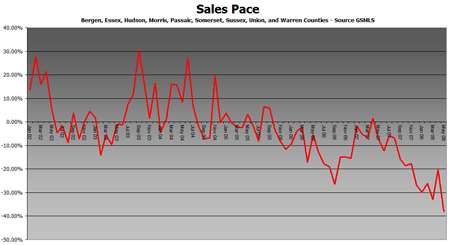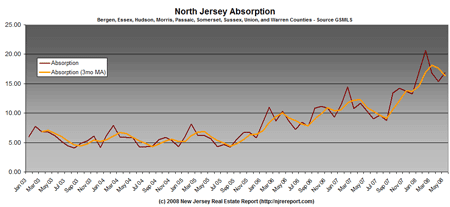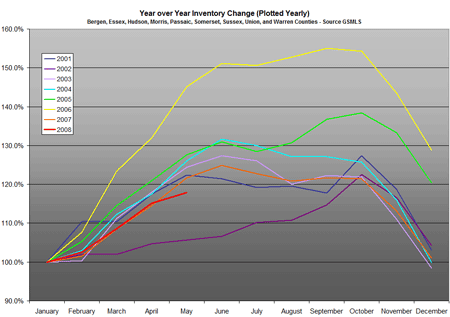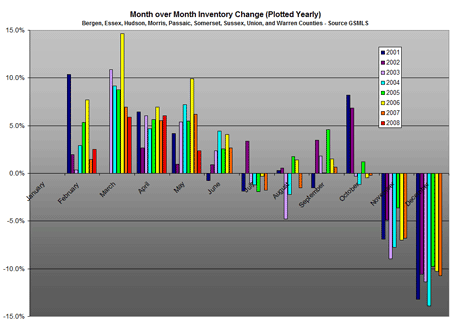On May 13th, the National Association or Realtors released their first quarter 2008 sales data, which indicated that sales in New Jersey were up 4% year over year. Almost immediately I suspected there was an issue with the data, their published figures didn’t correlate, at all, with the datasets that I actively monitor. The numbers simply didn’t make any sense. While I don’t actively monitor sales throughout the entire state, the areas that I monitor are large enough to be representative of activity across the state. I went on record, shortly after analyzing the data, with my opinion: the published data was wrong. The pundits went on record with positive comments about the health of the New Jersey market:
“Unlike most of the nation, the New Jersey housing market remains stable,” said Drew Fishman, CRS, 2008 New Jersey Association of Realtors (NJAR) president. “Nationally, total sales for single-family homes, condominiums and co-ops dropped by 22 percent from the previous year, while New Jersey was one of three states to show an increase. This is just further evidence that New Jersey does not follow national real estate trends.”
…
“New Jersey’s housing market continually outperforms other areas of the country,” said Jarrod C. Grasso, RCE, NJAR executive vice president. “The Garden State’s proximity to New York City and Philadelphia, its extensive transportation infrastructure and many other positive market forces contribute to the state’s healthy real estate market.”
The NJAR clearly believed that the NAR published first quarter data was correct, and went on record not with concern that the data might not be accurate, but that it was indeed accurate, and was proof that the New Jersey real estate market was doing well.
Contrast this to my own comments:
Comment posted on May 14th:
grim Says:
May 14th, 2008 at 9:10 am
#26 – I don’t believe the number of sales increased in NJ.
NJMLS, GSMLS and Monmouth/Ocean MLS show steep declines over last year. In addition, the NJ areas that are covered by Prudential Fox and Roach (Philly region) were showing large YOY declines as well.
Where did home sales increase so dramatically in NJ, as to overcome the steep declines seen across the regions I actively monitor?
Sorry, but I don’t buy these numbers, call me a conspiracy theorist if you want. They don’t correlate at all with other published sources.
Comment posted on May 14th:
grim Says:
May 14th, 2008 at 9:51 am
The NAR reported numbers are incorrect.
There is no way NJ sales are up 4% from Q1 2007, the data has got to be wrong.
I’m going on record with this statement.
I immediately attempted to contact the NAR to request the data, despite the fact that it would cost me $75 to do so.
Email sent to the National Association of Realtors on May 14th:
from James Bednar
to data@realtors.org
date Wed, May 14, 2008 at 10:08 AM
subject New Jersey Existing Homes Survey Data
Is it possible to request the underlying raw survey data for the New Jersey EHS Series? I have a concern that the most recently reported state EHS numbers for New Jersey do not match what I am seeing at the MLS level. I am a member of a number of state MLS boards, and have access to the county level data from each. The reported increase of 4% from 2007.q1 to 2008.q1 simply doesn’t correlate with the county level data I am seeing.
Is it possible to request the underlying raw data series that this report is based on, for the state of NJ? 2000-Current?
If not, would it be possible to get a list of the NJ MLS systems that participate in the survey, and the reported counts?
Much appreciated,
James Bednar
DRI Real Estate, Inc
NRDS# (redacted)
Comment posted on May 14th:
grim Says:
May 14th, 2008 at 10:15 am
I’ve asked the NAR for the underlying raw survey data for NJ.
If they agree to provide it, it will cost me $75.
The same email was sent on the 15th, 16th, 18th and 19th. I sent the following additional email on the 19th with all the prior requests attached:
from James Bednar
to data@realtors.org
date Mon, May 19, 2008 at 1:26 PM
subject Re: New Jersey Existing Homes Survey Data
To whom it may concern,
Is this the appropriate email address for data requests?
See below.
Thank you,
James Bednar
Email sent to Jeff Otteau on May 14th:
from James Bednar
to Jeffrey Otteau
date Wed, May 14, 2008 at 11:54 AM
subject First Quarter Otteau Report
Jeffrey,
I’m trying to reconcile the Q1 Otteau Reports with the Q1 EHS data released by the NAR yesterday.
According to the data you publish, first quarter sales in NJ were down by double digit percentages, see below:
CountyQ1.2007Q1.2008% change
Atlantic318.7237.3-25.5%
Bergen807.3542.7-32.8%
Camden534.3352-34.1%
Cape May196.3170.3-13.2%
Cumberland42.331-26.7%
Essex426.7330.3-22.6%
Gloucester276204.7-25.8%
Hudson344.3258.3-25.0%
Hunterdon120.3111.3-7.5%
Mercer290.3217.3-25.1%
Middlesex706.7523-26.0%
Monmouth741.3573-22.7%
Morris480.7364.7-24.1%
Ocean751.3562-25.2%
Passaic263.3213.7-18.8%
Salem5131-39.2%
Somerset362.3248.3-31.5%
Sussex167.7125-25.5%
Union365.7270.7-26.0%
Warren108.376.7-29.2%
Likewise, I’m seeing double digit declines on GSMLS:
GSMLS – First Quarter Sales
Bergen,Essex,Hudson,Morris,Passaic,Somerset,Sussex,Union,Warren Counties
SFH, Condo, Coop
2003 – 5619
2004 – 5862
2005 – 5787
2006 – 5573
2007 – 5316
2008 – 3718
Down 30% YOY
And NJMLS:
NJMLS – SFH, Condo, Coop
Closed Sales – Q1
2007 – 2718
2008 – 2002
Down 26%
Contract Sales – Q1
2007 – 3771
2008 – 2784
Down 26%
Any comments? Clearly someone is very, very wrong.
Thanks,
James
Email to Pretorius on May 14th:
from James Bednar
to (Redacted)
date Wed, May 14, 2008 at 10:02 AM
subject Re: NJ home sales
(redacted),
Those numbers can’t be correct, I’m writing the NAR to request the underlying data for the series.
It is going to cost me $75 to ask them the question.
Otteau has Q1 sales down by double digits YOY, NSA for NJ. GSMLS, NJMLS, MOMLS are all showing similar patterns.
In fact, I can find no area in NJ that has shown a YOY increase.
Something is wrong here.
jb
—————————
On May 14th, 15th, 16th, 18th, and 19th, I sent a data request to the NAR for the underlying survey data that is the basis for the quarterly result. They did not acknowledge my requests, nor did they acknowledge my phone calls, despite the fact I’m a Realtor.
—————————
From the Star Ledger:
NJ home sales plunged 30 percent in first quarter
When the National Association of Realtors issued its first-quarter report on the health of the housing market last month, New Jersey was singled out as one of only three states that saw the volume of home sales increase during the first three months of the year.
On Friday, the Realtors’ group issued a huge correction, saying that instead of a slight increase, New Jersey’s housing market actually saw a 30 percent drop in home sales during the first quarter compared with the same period last year.
“It happened in the crunching of the numbers,” said NAR spokesman Lucien Salvant. “It was just a mistake and we owned up to it.”
As it turns out, only 114,100 homes were sold across the state during the first quarter – nearly a third less than the 163,000 sales recorded in the first three months of 2007.
Jeffrey Otteau, president of the East Brunswick research firm Otteau Valuation Group, said he suspected the NAR’s original numbers were out of whack when they were issued May 13.
“When they came out with that report, we turned it inside out and upside down and we couldn’t make any sense of it,” Otteau said.
Based on his own calculations, home sales in New Jersey fell 26 percent during the first quarter of this year compared with the first quarter of 2007.
Otteau said things picked up in April. According to his figures, April home sales increased 9.3 percent from March – the first March-to-April increase since 2005.
“The housing market in New Jersey really is beginning to show signs of improvement, so that is still valid,” he said.
And, according to Otteau’s April calcuations, the average house now sits on the market for 10 months, down from 13 months in January.
The NAR said there were no data-crunching problems with sales figures in other states. In addition, the New Jersey error did not affect home price data. During the first quarter, the median home price for New Jersey was $350,700, down from $361,300 in the first quarter of 2007.
In response to the retraction by the national group, the New Jersey Association of Realtors said sales agents around the state were the first ones to bring the mistake to their attention.

